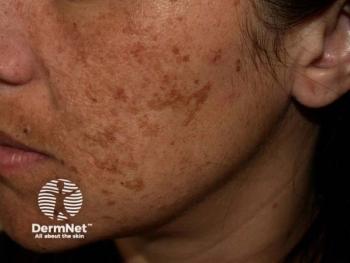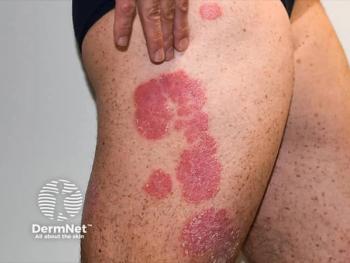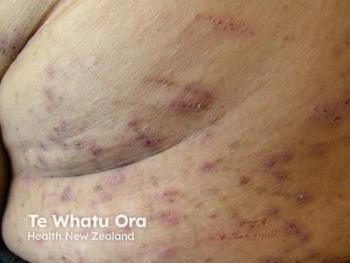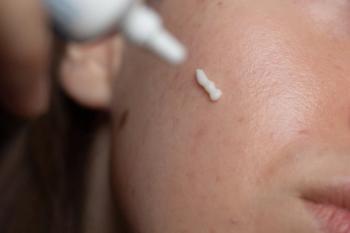
Apremilast Shows Promise in Genital Psoriasis
Key Takeaways
- Genital psoriasis with pustular features poses significant treatment challenges due to anatomical sensitivities and limited efficacy of topical agents.
- Apremilast, a PDE4 inhibitor, showed complete clinical remission in all study participants with treatment-resistant genital psoriasis.
A retrospective case series found that apremilast induced complete remission in 6 men with treatment-resistant genital psoriasis.
Genital psoriasis, particularly when presenting with pustular features, represents a rare and diagnostically challenging subtype of the disease.1 A recent retrospective case series published in JEADV Clinical Practice evaluates the efficacy of apremilast, an oral phosphodiesterase 4 (PDE4) inhibitor, in treating this underrecognized condition among male patients with treatment-resistant disease. The findings offer new insights into a potential therapeutic option for patients who have exhausted both topical and traditional systemic therapies.2
Background and Clinical Challenge
Patients with genital psoriasis may experience significant physical discomfort, sexual dysfunction, and psychosocial distress. Due to anatomical sensitivities and limited efficacy of conventional topical agents like corticosteroids and calcineurin inhibitors, systemic treatments are often required. However, commonly used agents such as methotrexate, acitretin, and ciclosporin carry risks of hepatotoxicity, mucocutaneous adverse effects, and patient intolerance, limiting their long-term utility.
Biologic therapies such as ixekizumab have shown promise but are often inaccessible to patients with limited disease involvement, such as exclusive genital psoriasis.3 This therapeutic gap highlights the need for alternatives like apremilast, which has a more favorable safety profile and ease of oral administration.
Study Design and Methods
The study included 6 men aged 21 to 47 years with histologically confirmed pustular features localized to the glans penis or glans and prepuce. All had a clinical history of circinate balanitis and failed multiple prior treatments, including potent topical steroids, tacrolimus, acitretin, methotrexate, and ciclosporin. Notably, diagnostic work-up for sexually transmitted infections and systemic features of reactive arthritis returned negative in all cases.
Patients initiated apremilast on a standard 6-day titration schedule, reaching a maintenance dose of 30 mg twice daily. One patient required dose adjustment to once daily due to migraines. Follow-up ranged from 1 to 3 months.
Results
All 6 patients achieved complete clinical remission within 1 to 3 months of treatment initiation. Adverse effects were minimal and transient, with diarrhea being the most commonly reported but self-limiting within 2 weeks. No patient exhibited extragenital psoriasis or psoriatic arthritis during the study period, and none required adjunctive therapies.
Histopathological findings supported the diagnosis of pustular psoriasis, though variability in presentation—particularly in genital areas—was noted. While intraepidermal neutrophilic micro-abscesses and parakeratosis were present, fully formed pustules were often absent, underlining the importance of correlating histology with clinical features like ring-shaped (circinate) lesions.
Clinical Implications
The rapid and complete response seen across all cases supports apremilast as a potentially effective and well-tolerated treatment for refractory genital psoriasis with pustular features. Its mechanism—targeting pro-inflammatory cytokines via PDE4 inhibition—makes it particularly suitable for localized disease where inflammation predominates.
Given the rarity of this condition and the small cohort studied, researchers stated these findings should be interpreted with caution. However, they are consistent with previous reports of apremilast’s efficacy in challenging psoriasis presentations, such as palmoplantar pustulosis and genital involvement. Importantly, the ease of administration and low incidence of serious adverse effects favor its use in sensitive anatomical locations.
Conclusion
This retrospective case series adds to the growing body of evidence supporting apremilast as a valuable therapeutic alternative for patients with genital psoriasis unresponsive to conventional treatments. While further studies, including randomized controlled trials, are necessary to validate these results and determine long-term outcomes, the findings underscore the importance of clinical awareness and histological confirmation in the management of this rare but impactful condition.
By offering a non-biologic, oral treatment option with a favorable safety profile, apremilast may bridge an important therapeutic gap for patients facing limited options due to the anatomical site or treatment contraindications.
References
- Larsabal M, Ly S, Sbidian E, et al. GENIPSO: a French prospective study assessing instantaneous prevalence, clinical features and impact on quality of life of genital psoriasis among patients consulting for psoriasis. Br J Dermatol. 2019;180(3):647-656. doi:10.1111/bjd.17147
- Krygier J, Sass U, and Richert B. Efficacy of apremilast in refractory genital psoriasis: A retrospective case series. JEADV Clinical Practice. doi:10.1002/jvc2.70120.
- Hong JJ, Mosca ML, Hadeler EK, Brownstone ND, Bhutani T, Liao WJ. Genital and inverse/intertriginous psoriasis: An updated review of therapies and recommendations for practical management. Dermatol Ther (Heidelb). 2021;11(3):833-844. doi:10.1007/s13555-021-00536-6
Newsletter
Like what you’re reading? Subscribe to Dermatology Times for weekly updates on therapies, innovations, and real-world practice tips.


















